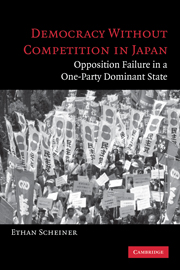Book contents
- Frontmatter
- Contents
- Tables and Figures
- Glossary of Abbreviations
- Acknowledgments and a Note on the Use of the Online Appendix
- Introduction: The Puzzle of Party Competition Failure in Japan
- 1 The Importance of Party Competition and a Model of Party Competition Failure
- 2 Opposition Failure in Japan: Background and Explanations
- 3 Clientelism and Its Determinants
- 4 The Impact of Clientelism and Centralized Government Financial Structure: Comparative Analysis
- 5 Local Opposition Failure in Japan
- 6 National-Level Opposition Failure: The Impact of Subnational-Level Weakness
- 7 Political Economy Changes and Their Impact on Party Systems: Comparative Analysis
- 8 Parallel Party Systems: Political Economy Changes and the Limits to Anti-Clientelist Appeals in Japan
- 9 The Problem of Organization and Coherence in Top-Down Party Formation
- 10 Conclusion: Democracy Without Competition
- References
- Index
Introduction: The Puzzle of Party Competition Failure in Japan
Published online by Cambridge University Press: 02 December 2009
- Frontmatter
- Contents
- Tables and Figures
- Glossary of Abbreviations
- Acknowledgments and a Note on the Use of the Online Appendix
- Introduction: The Puzzle of Party Competition Failure in Japan
- 1 The Importance of Party Competition and a Model of Party Competition Failure
- 2 Opposition Failure in Japan: Background and Explanations
- 3 Clientelism and Its Determinants
- 4 The Impact of Clientelism and Centralized Government Financial Structure: Comparative Analysis
- 5 Local Opposition Failure in Japan
- 6 National-Level Opposition Failure: The Impact of Subnational-Level Weakness
- 7 Political Economy Changes and Their Impact on Party Systems: Comparative Analysis
- 8 Parallel Party Systems: Political Economy Changes and the Limits to Anti-Clientelist Appeals in Japan
- 9 The Problem of Organization and Coherence in Top-Down Party Formation
- 10 Conclusion: Democracy Without Competition
- References
- Index
Summary
Japanese party politics are a puzzle. In 1955, the Liberal and Democratic Parties merged to form the conservative Liberal Democratic Party. The LDP's precursors had dominated the Japanese government since the prewar period, and the LDP's formation meant that a single party was in control. Given the seemingly incompatible personalities and policy positions – as well as intraparty antagonism – of those forming the LDP, many Japanese were skeptical of the new party's ability to stay together (Calder 1988: 59–60). But power proved to be impressive glue; the party remained largely intact for decades. That power helped hold the party together is hardly shocking. However, the LDP not only stayed together but also warded off nearly every electoral challenge over the next five decades: Between 1955 and 2005 (when this book was completed), the LDP was out of power for a total of ten months and 20 days.
Two points make this puzzle all the more difficult to understand. First, Japan is a democracy. Citizens maintain all the usual civil liberties, and non-LDP parties contest elections, hoping to topple the LDP. Second, and most troubling, the LDP is not popular. As of the writing of this book, it had been over 40 years since the party received a majority of the vote in an election for the national House of Representatives.
- Type
- Chapter
- Information
- Democracy without Competition in JapanOpposition Failure in a One-Party Dominant State, pp. 1 - 6Publisher: Cambridge University PressPrint publication year: 2005



